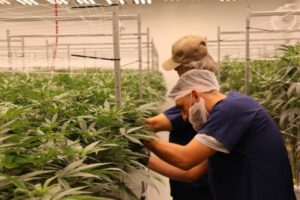From cultivation to retail sales, illicit operators are undercutting legal businesses that pay steep licensing fees, jump through ever-changing regulatory hurdles, and contribute significant tax dollars to state and local economies. Often, illicit operators can be found directly in front of licensed brick-and-mortar storefronts. They price their untested and counterfeit goods far below anything inside a legal dispensary. Calling law enforcement officers can result in retaliatory vandalism, but there are proactive steps the legal industry can take to discourage this type of illegal competition.
Here are five suggestions for business owners and managers who want to support the legal cannabis industry.
- Educate the public and politicians about the quality and costs of regulated versus unregulated products.
Unlicensed operators often turn out inferior products with inconsistent quality made from plants grown with harmful pesticides. The products threaten the health of consumers and can result in the unfair payment, treatment, and poor health of workers.
Many unlicensed cultivators and producers damage the natural environment. Some draw an inordinate amount of energy from the power grid, which can cause electrical shortages and higher costs for the community. Unlicensed operators also often run cultivation sites in ways that encourage violence in the community, sucking up time and resources from local law enforcement agencies.
“If there’s an easier, cheaper way to get cannabis, consumers will seek it out,” said Andrew Freedman, executive director at the Coalition for Cannabis Policy, Education, and Regulation (CPEAR), a D.C.-based nonprofit that advances policy solutions for cannabis legalization and regulation. “But overall, consumers have become more savvy and understanding. Medical cannabis consumers especially want to know their products are safe. Many consumers want to ensure their products do not damage the environment.”
According to Shanita Penny, director of the Center for Excellence at CPEAR, and former president of the Minority Cannabis Business Association, illicit and unregulated cultivators hire migrant farm workers who may be victims of human trafficking and violence.
“Licensed operators should work with labor, human rights, and/or immigration-focused nonprofits to remind the public and politicians that unlicensed operators often do not pay their workers,” said Penny. “Sometimes they even threaten or kill their workers at the end of harvest to avoid payment and keep the project secret.”
- Advocate for more licenses to be awarded. A shortage of cannabis businesses can result in under-serving many areas in a region or state, leading to pockets of illicit operators.
“States that license operators quickly have less of a problem with meeting market demand,” said Penny.
When a city has a high number of licensed operators, particularly those with resources to meet a variety of consumers, it may expect to see fewer temporary pop-up shops.
“Then the police have a better perception of the cannabis industry, said Freedman.” “They can stop playing ‘Whack-A-Mole’ with unlicensed storefronts that pop up around a city.”
New York City and Los Angeles have both seen concerns with inordinate numbers of unlicensed pop-up stores. San Francisco and Los Angeles also have seen concerns with unlicensed indoor cultivation sites, particularly in industrial spaces. Companies that skirt regulations tend to do so in ways that lead to problems like fires.
- Support programs that help formerly illicit operators pay basic fees and learn how to run their businesses. In particular, remove barriers for minority business owners.
“In D.C., the hard work to bring people who want to run legitimate businesses into the fold is happening,” said Penny.
In Penny’s eyes, one of the basic steps is to lower the barriers to entry by reducing licensing fees to around $400. This presents less of an obstacle than the tens of thousands of dollars often required for a cannabis business license.
“People may not have that kind of money upfront,” said Penny. “Alternatively, they may also be unwilling to spend that amount without an understanding of their ROI.”
- Support the implementation of state and local regulatory systems.
“States that have legalized cannabis or recreational cannabis recently are typically slower to roll out regulatory systems,” said Freedman. The demand for cannabis does not go away while states are engaged with the rollout. According to Freedman, getting new systems in place quickly ensures consumers and businesses have the information they need to familiarize themselves with details like the cost of licensing, how to raise capital, and how to work within the regulatory framework to launch a legal business as fast as possible.
- Support packaging regulations that clarify dosage and state of origin and identify licensed operators. Also, educate consumers and politicians as to why packaging regulations are important.
Many consumers on the East Coast have been fooled into thinking all products grown in California are of high quality. They also perceive all products with the word “California” in the name or on the packaging as high quality.
“For years, California cannabis has enjoyed a good reputation,” said Penny. “But in reality, many products from California haven’t even been tested, or worse, tested and failed. Testing is a significant benefit for consumers.”
Freedman acknowledges that all of the steps above take time. Licensed operators can make progress faster by using regular events like 420 celebrations to share information with the public. They can also intensify lobbying efforts during election season. Licensed operators should also ask their city, county, and state for data relating to illicit operators, such as how many unlicensed cultivation sites in an area have been shut down. This helps everyone measure current concerns and ensures local and state responses aren’t happening in a vacuum.
“Despite the setbacks, the effort to discourage the illicit market is working,” said Freedman. “Every year, substantially more sales go through the legal market than the illicit market. Every dollar spent in the regulated system is a dollar that’s not in the illicit system. We’ve sped the process up by working together.”
- SEO Powered Content & PR Distribution. Get Amplified Today.
- PlatoAiStream. Web3 Data Intelligence. Knowledge Amplified. Access Here.
- Minting the Future w Adryenn Ashley. Access Here.
- Buy and Sell Shares in PRE-IPO Companies with PREIPO®. Access Here.
- Source: https://mgmagazine.com/business/legal-politics/how-to-discourage-illicit-cannabis-businesses/
- :has
- :is
- :not
- $UP
- a
- About
- above
- According
- advances
- advocate
- agencies
- All
- also
- amount
- an
- and
- Andrew
- Angeles
- anything
- ARE
- AREA
- areas
- around
- AS
- At
- avoid
- awarded
- away
- barriers
- basic
- BE
- become
- been
- below
- benefit
- Better
- both
- Brian
- bring
- business
- business owners
- businesses
- but
- by
- california
- calling
- CAN
- cannabis
- cannabis business
- Cannabis Industry
- Cause
- Center
- cheaper
- City
- Coast
- community
- Companies
- competition
- concept
- Concerns
- Consumers
- contribute
- Cost
- Costs
- Counterfeit
- county
- creativity
- cultivation
- Current
- D.C.
- data
- Demand
- details
- directly
- Director
- do
- does
- Dollar
- dollars
- dosage
- down
- draw
- during
- easier
- East
- east coast
- economies
- educate
- Education
- effort
- efforts
- Election
- encourage
- end
- energy
- enforcement
- engaged
- ensure
- ensures
- entry
- Environment
- especially
- Even
- events
- ever-changing
- Every
- everyone
- Excellence
- executive
- Executive Director
- expect
- Eyes
- Failed
- familiarize
- far
- farm
- FAST
- faster
- Fees
- fewer
- For
- For Consumers
- Former
- formerly
- found
- Framework
- Francisco
- freedman
- from
- front
- get
- getting
- Go
- good
- goods
- Grid
- grown
- Happening
- Hard
- hard work
- harmful
- harvest
- Have
- Health
- help
- helps
- High
- higher
- hire
- How
- How To
- HTTPS
- human
- human rights
- Hurdles
- identify
- Illegal
- illicit
- implementation
- important
- in
- Indoor
- industrial
- industry
- information
- Innovation
- into
- IT
- Jackson
- jpg
- jump
- Keep
- Kill
- Kind
- Know
- labor
- launch
- Law
- law enforcement
- lead
- leading
- LEARN
- Legal
- legalization
- legalized
- legitimate
- less
- License
- Licensed
- licenses
- Licensing
- light
- like
- lobbying
- local
- los
- Los Angeles
- made
- make
- Managers
- many
- Market
- May..
- measure
- medical
- medical cannabis
- Meet
- meeting
- minority
- money
- more
- name
- Natural
- Need
- New
- Nonprofit
- nonprofits
- number
- numbers
- obstacle
- of
- officers
- often
- on
- ONE
- ones
- operators
- or
- Origin
- out
- overall
- owners
- packaging
- particular
- particularly
- Pay
- payment
- People
- perception
- Place
- plants
- plato
- Plato Data Intelligence
- PlatoData
- playing
- pockets
- Police
- policy
- Politicians
- poor
- pop
- pop-up
- possible
- power
- Power grid
- presents
- president
- price
- Proactive
- Problem
- process
- Producers
- Products
- Programs
- Progress
- project
- public
- quality
- quickly
- raise
- Reality
- recently
- Recreational
- reducing
- region
- regular
- regulated
- Regulation
- regulations
- regulatory
- remove
- reputation
- required
- Resources
- responses
- result
- retail
- Retail Sales
- rights
- ROI
- Roll
- rollout
- ROW
- Run
- safe
- Said
- sales
- San
- San Francisco
- savvy
- Season
- Secret
- see
- Seek
- seen
- Setbacks
- Share
- shops
- shortage
- shortages
- should
- Shut down
- shutterstock
- significant
- Sites
- So
- solution
- Solutions
- some
- spaces
- spend
- spent
- State
- States
- Steps
- Stop
- stores
- substantially
- such
- support
- system
- Systems
- Take
- tax
- temporary
- tens
- than
- that
- The
- the information
- their
- themselves
- There.
- they
- Thinking
- this
- those
- thousands
- threaten
- Through
- time
- to
- together
- trafficking
- treatment
- TURN
- type
- typically
- understanding
- unfair
- using
- Vacuum
- variety
- Versus
- victims
- want
- Way..
- ways
- which
- while
- WHO
- why
- will
- with
- within
- without
- Word
- Work
- workers
- working
- worse
- year
- years
- york
- you
- zephyrnet












